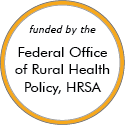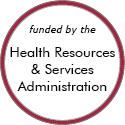Rural Project Examples: Healthcare needs and services
Other Project Examples
MIST: Mothers and Infants Sober Together

Updated/reviewed May 2023
- Need: To address the needs of pregnant women who are using substances and infants born into drug-positive families.
- Intervention: The Mothers and Infants Sober Together (MIST) program assisted mothers who used substances get treatment and provide a safe, drug-free home for themselves and their newborn.
- Results: MIST has helped mothers find treatment and education and has helped children grow up in safe and healthy homes.
The Minnesota Integrative Behavioral Health Program
Updated/reviewed May 2023
- Need: Out of 79 Critical Access Hospitals (CAHs) surveyed in Minnesota in 2015, behavioral health was the most frequently cited service requested.
- Intervention: In response, Rural Health Innovations launched the Minnesota Integrative Behavioral Health Program. This initiative engaged representatives across all sectors in health integration between hospital, primary care, and community services.
- Results: Strategy sessions resulted in the creation of resource directories to improve care coordination, evaluation measurements to document results, and an overall better understanding of integrative care challenges.
Outer Cape Health Services Community Resource Navigator Program

Updated/reviewed March 2023
- Need: Improving outcomes for Outer and Lower Cape Cod residents in need of social, behavioral health, and substance use disorder services while reducing the burden and costs to town agencies and hospital emergency rooms.
- Intervention: The Community Resource Navigator Program works with local social services, town agencies, faith-based institutions, hospitals, the criminal justice system, and others to identify and connect clients to needed services.
- Results: Clients are gaining access to the care they were once lacking, as measured by improvements in self-sufficiency. The program also helps community partners and stakeholders work together to reduce the impact of risks associated with behavioral health symptoms, substance use disorder, and social determinants of health.
Addiction Recovery Mobile Outreach Team (ARMOT)

Updated/reviewed January 2023
- Need: To reduce the number of overdoses and overdose-related deaths from opioids in rural Pennsylvania.
- Intervention: ARMOT provides 1) case management and recovery support services to individuals with substance use disorders and 2) education and support to rural hospital staff, patients, and their loved ones.
- Results: Since 2015, ARMOT has received over 2,956 referrals.
Partners in Health and Wholeness
Updated/reviewed December 2022
- Need: To lessen the impact of chronic disease and associated complications in North Carolina.
- Intervention: Partners in Health and Wholeness, an initiative of the NC Council of Churches, is a faith-based program that integrates healthy living within congregations while offering financial support to launch or expand health initiatives. The program partners with faith communities in North Carolina to fund and support their health initiatives through collaborative partnerships.
- Results: Since its founding in 2009, over 900 churches have become a part of the PHW, many in rural areas, and over 600 mini-grants have been awarded to congregations.
San Luis Valley Public Health Partnership
Updated/reviewed December 2022
- Need: Public health departments in Colorado's rural San Luis Valley region desired to share public health services to improve health outcomes in the region.
- Intervention: Six counties joined in a public health cross-jurisdictional sharing arrangement. The partnership has served as a forum for sharing and evaluating opportunities to improve health access and core public health services.
- Results: The partnership has enabled health departments to share expertise and develop regional projects to provide a broader range of public health services.
Health-e-Schools

Updated/reviewed October 2022
- Need: Rural school children lack proper healthcare resources within the school setting.
- Intervention: Health-e-Schools provides health services to students via telehealth using video conferencing and special equipment.
- Results: Health-e-Schools increases access to primary healthcare, increases attendance in the classroom, and decreases the amount of time that parents or guardians must take off of work to bring their child to health-related appointments.
Indiana ASPIN Veteran's Services

Updated/reviewed October 2022
- Need: To address the lack of mental healthcare options for rural veterans.
- Intervention: A telebehavioral health hub network was created to connect community mental health centers to the VA Medical Center.
- Results: More than 3,000 telehealth appointments have been made, saving hundreds of veterans time and money.
ASPIN's Certified Recovery Specialist Program


Updated/reviewed September 2022
- Need: Improved approach in addressing the behavioral health and primary care disparities of Indiana's rural counties.
- Intervention: A network was established that trained community health workers (CHWs) to be certified health insurance enrollment navigators and provide mental health services.
- Results: This year, ASPIN trained 230 CHWs, cross-trained 70 behavioral health case managers as CHWs, and 35 individuals in the Indiana Navigator Pre-certification Education.
Isanti County SafeCab Program
Updated/reviewed August 2022
- Need: To reduce the number of deaths and injuries caused by drunk driving in Isanti County.
- Intervention: The SafeCab program provides alternative transportation home for bar patrons who would otherwise drive impaired.
- Results: The program is credited with a significant decrease in DUI (Driving Under the Influence) arrests and the lower average corresponding BAC (Blood Alcohol Content) levels in Isanti County.
For examples from other sources, see:
